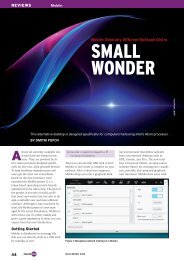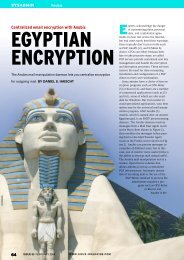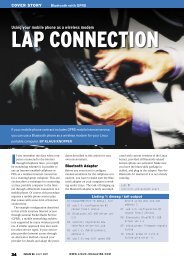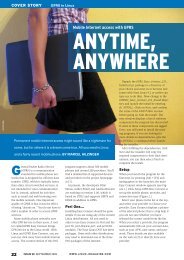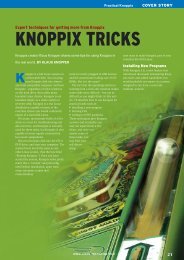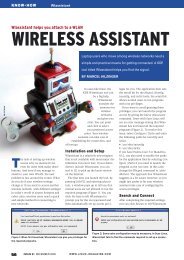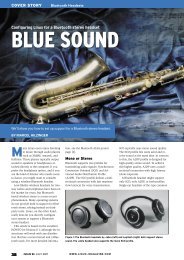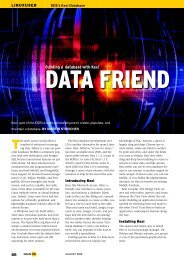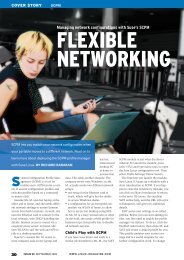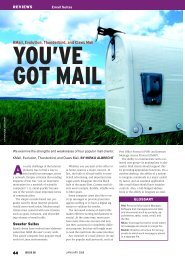Hotplugging with Udev, HAL, and D-Bus - Linux Magazine
Hotplugging with Udev, HAL, and D-Bus - Linux Magazine
Hotplugging with Udev, HAL, and D-Bus - Linux Magazine
You also want an ePaper? Increase the reach of your titles
YUMPU automatically turns print PDFs into web optimized ePapers that Google loves.
LINUX KNOW-HOW USER<br />
Schlagwort <strong>Hotplugging</strong> sollte hier stehen<br />
<strong>Hotplugging</strong> <strong>with</strong> <strong>Udev</strong>, <strong>HAL</strong>, <strong>and</strong> D-<strong>Bus</strong><br />
HOT WIRED<br />
Hardware which just works is what<br />
every user wants. Current <strong>Linux</strong><br />
distributions go a long way to<br />
fulfilling that dream. In this article,<br />
we will be investigating how the<br />
hotplug system works.<br />
BY OLIVER FROMMEL, MARCEL HILZINGER AND RENÉ REBE<br />
Is it really that difficult You only<br />
wanted <strong>Linux</strong> to launch the right<br />
program when you attached your<br />
new digital camera, but the operating<br />
system has decided to sit this one out.<br />
This scenario is all too common,<br />
although the situation has started to<br />
improve. <strong>Linux</strong> should h<strong>and</strong>le any kind<br />
of hardware correctly, but the ability to<br />
manage USB <strong>and</strong> Firewire devices<br />
plugged in or unplugged while the computer<br />
is running (known as hotplugging<br />
[1]) has become increasingly important.<br />
This article explains what a modern<br />
<strong>Linux</strong> system does <strong>with</strong> the devices you<br />
attach to it, <strong>and</strong> why not everything<br />
works as planned.<br />
Agents at Work<br />
When you plug in a device that<br />
supports hotplugging, the kernel<br />
sends an event signal to the hotplug<br />
system. The hotplug system<br />
uses <strong>Udev</strong> to create a device file<br />
for the device <strong>and</strong> then calls the<br />
appropriate agent. An agent is a<br />
script, typically stored below<br />
the /etc/hotplug/ directory, that<br />
manages the actions associated <strong>with</strong> a<br />
hotplug event. In this case, the agent<br />
manages the task of adding <strong>and</strong> registering<br />
the new device.<br />
The steps the agent performs may<br />
vary depending on your distribution <strong>and</strong><br />
the type of hardware you are installing.<br />
Since most hotplug-capable hardware<br />
attaches to a USB port, the USB agent is<br />
perhaps a good example. The USB agent<br />
first checks if a driver is available for the<br />
new device (for example, isdn) <strong>and</strong> then<br />
calls modprobe to load the module. If the<br />
agent finds a script <strong>with</strong> the same name<br />
as the driver in the /etc/hotplug/usb/<br />
directory, the agent runs that script.<br />
The act of loading modules typically<br />
triggers a few more hotplug events,<br />
Figure 1: After you modify the<br />
<strong>Udev</strong> configuration file, the<br />
Gnome desktop icon has a<br />
more intuitive label.<br />
which in turn start other agents. It is<br />
common for multiple hotplug agents to<br />
work together. For example, when you<br />
connect an external hard disk, first the<br />
USB agent loads, then the SCSI agent<br />
loads to mount the individual partitions<br />
as SCSI devices <strong>with</strong> the help of the usbstorage<br />
module. If you attach a Bluetooth<br />
dongle, the USB agent runs first, followed<br />
by a Bluetooth agent called bluetooth.agent.<br />
Blacklisting Drivers<br />
The /etc/hotplug/blacklist file has a list<br />
of modules that no agent is allowed to<br />
load. The list includes the modules that<br />
Figure 2: The hal-device-manager <strong>with</strong> detailed information for the<br />
Prism2 WLAN adapter.<br />
48<br />
48 ISSUE 53 APRIL 2005 WWW.LINUX- MAGAZINE.COM
<strong>Hotplugging</strong><br />
KNOW-HOW<br />
the system loads via other services, as<br />
well as modules that prevent power<br />
management.<br />
<strong>Linux</strong> typically requires a device file in<br />
order to interact <strong>with</strong> a device. In a hotplug<br />
situation, that device file must be<br />
created on the fly when the new device<br />
is detected. As you learned in the preceding<br />
section, hotplug uses <strong>Udev</strong> to create<br />
the device file prior to summoning<br />
the agent.<br />
Device Files as Needed<br />
<strong>Udev</strong> [1] is the designated successor to<br />
static device files, <strong>and</strong> most current distributions<br />
now use it. The purpose of<br />
<strong>Udev</strong> is to create device files based on<br />
rules specified in a <strong>Udev</strong> configuration<br />
file. For example, if you want to assign a<br />
device file other than sda1 to your MP3<br />
stick, you could specify this requirement<br />
in your own <strong>Udev</strong> rule.<br />
<strong>Udev</strong> rules are stored in /etc/udev/<br />
rules.d. If you look in that directory, you<br />
will find a file that describes typical<br />
devices: in Ubuntu this is udev.rules,<br />
whereas Fedora uses 50-udev.rules. <strong>Udev</strong><br />
reads the files in alphabetic order. If you<br />
want to load your own <strong>Udev</strong> rule before<br />
The Suse <strong>Linux</strong> approach to hotplugging<br />
is different in parts, <strong>and</strong> the current version<br />
does not use the <strong>HAL</strong> architecture.<br />
It distinguishes between (currently)<br />
unknown <strong>and</strong> configured devices <strong>and</strong><br />
uses the hwup, hwdown, hwstatus, <strong>and</strong><br />
hwscanqueue programs to support hotplugging.<br />
Suse stores a configuration<br />
file in /etc/sysconfig/hardware for configured<br />
devices. When the kernel registers<br />
a hotplug event, /sbin/hotplug loads the<br />
appropriate kernel module.<br />
No <strong>HAL</strong><br />
After loading the kernel module, hwup<br />
checks if there is a configuration file for<br />
the device below /etc/sysconfig/hardware<br />
<strong>and</strong>, if so, loads the modules specified<br />
by the file. If hwup fails to locate a<br />
configuration file, it attempts to locate<br />
the required modules by reading the<br />
*.usermap files in /etc/hotplug/, just as<br />
other distributions do.<br />
In the future, Suse is looking to create a<br />
file below /etc/sysconfig/hardware for<br />
every hardware component <strong>and</strong> to completely<br />
do <strong>with</strong>out usermap files. Comparing<br />
the last two Suse versions shows<br />
that Suse is already heading in this<br />
direction. Whereas 9.1 only creates configuration<br />
files for network devices, 9.2<br />
the global rules, you will need to assign<br />
a filename to ensure that this happens,<br />
for example 10-local.rules. The following<br />
entry is good for a no-name MP3 stick:<br />
BUS="usb", SYSFS{idProduct}=U<br />
"1000", SYSFS{idVendor}="10d6",U<br />
NAME="mp3disk"<br />
Figure 3: In Gnome 2.8, gnome-volumeproperties<br />
specifies which application is run<br />
for which hotplug event.<br />
Box 1: Hotplug on Suse <strong>Linux</strong><br />
This stops the Gnome desktop from displaying<br />
the generic sda1 label; instead<br />
the label is a more intuitive mp3disk<br />
(Figure 1). The lsusb tool, which lists the<br />
attached USB devices, will help you find<br />
the USB IDs. If a device file exists,<br />
udevinfo -q path -n /dev/devicefile displays<br />
the path in the SysFS (see “Box2:<br />
Device files <strong>with</strong> <strong>Udev</strong>”), but it does not<br />
give you the mount point /sys. You need<br />
the path as a parameter (-p), <strong>with</strong> this<br />
comm<strong>and</strong> to get SysFS information:<br />
udevinfo -a -p /block/hda/hda1<br />
...<br />
SYSFS{idVendor}="10d6"<br />
...<br />
This comm<strong>and</strong> helps you discover the<br />
device-specific values you need for special<br />
configurations. There is a detailed<br />
how-to for creating <strong>Udev</strong> files at [2]. The<br />
Fedora site has a short overview of the<br />
<strong>Udev</strong> system [3].<br />
Your Own Usermaps<br />
A usermap file contains one or multiple<br />
IDs that uniquely identify a hardware<br />
component. When a device that matches<br />
also has them for hard disks, CD/DVD<br />
drives, <strong>and</strong> a variety of USB devices.<br />
After hwup has finished, the hotplug<br />
agent launches. In the case of a USB<br />
event, the agent will be the USB agent;<br />
for network events, the agent will be the<br />
network agent; <strong>and</strong> so on. If the hotplug<br />
system fails to find a suitable agent, it<br />
launches a generic agent to create the<br />
required device files. In Suse <strong>Linux</strong> 9.2,<br />
the agent also looks in /etc/sysconfig for<br />
a configuration file for the service <strong>and</strong><br />
launches the appropriate service.<br />
Suse <strong>Linux</strong> has a simple approach to<br />
bug hunting that makes hotplug slightly<br />
more verbose. To enable this, set the<br />
variable HOTPLUG_DEBUG in<br />
/etc/syconfig/hotplug to yes or even to<br />
max. The latter setting tells the system<br />
to log every single step.<br />
Desktop Icons on Suse <strong>Linux</strong><br />
Suse <strong>Linux</strong> Version 9.1 or later does not<br />
create desktop icons for drives. Instead,<br />
users are expected to use the My Computer<br />
icon (just like in Windows) or to<br />
access drives directly via the drives:/<br />
URL. This solution can be a less than<br />
perfect for USB memory sticks. By<br />
default, Suse opens a Konqueror window<br />
<strong>with</strong> the content of the stick partition<br />
when you attach a memory stick,<br />
but if you have disabled this feature, or if<br />
you simply close the window, it’s back to<br />
My Computer.<br />
Suse <strong>Linux</strong> uses its own icons for the drives:/<br />
URL. They are located below /usr/<br />
share/hotplug/DesktopTemplates/. KDE<br />
adds the name to the ~/.kde/share/config/kio_drivesrc<br />
file. You can edit the file<br />
to assign intuitive <strong>and</strong> unique names to<br />
your devices. For example, if you have<br />
two memory sticks, you can simply edit<br />
the entries below [Used Names] to distinguish<br />
between them.<br />
To enable the device icons for the KDE<br />
desktop in Suse, you first need to install<br />
the kdebase3-extra <strong>and</strong> kdemultimedia3-<br />
extra packages. Take care if you have<br />
Suse 9.2: the packages are only on the<br />
DVD version! After completing the<br />
install, right click on the KDE desktop<br />
<strong>and</strong> select Configure desktop… in the<br />
drop-down menu. In the Behavior window,<br />
select Device icons <strong>and</strong> then check<br />
Enable icons on desktop. You can then<br />
use the list to specify which device icons<br />
you want to display on the desktop.<br />
After installing kdebase3-extra <strong>and</strong> kdemultimedia3-extra,<br />
the devices:/ URL will<br />
also work in Konqueror.<br />
WWW.LINUX- MAGAZINE.COM<br />
ISSUE 53 APRIL 2005<br />
49
KNOW-HOW<br />
<strong>Hotplugging</strong><br />
one of these entries is plugged into the<br />
system, the subsystem automatically<br />
runs the specified program, which can<br />
be a script.<br />
This allows you to enable a WLAN USB<br />
adapter that your distribution does not<br />
properly configure. In our lab, the hotplug<br />
system detected the adapter <strong>with</strong><br />
the Prism2 chipset, but it failed to run<br />
the script that launches the required<br />
WLAN functions.<br />
The lsusb comm<strong>and</strong> gives us the USB<br />
ID for the plugged in device. The vendor<br />
ID in our example is 0x0846, <strong>and</strong> the<br />
device ID is 0x4110.<br />
You now need to add the following<br />
hexadecimal values to a new file called<br />
/etc/hotplug/usb/prism2.usermap:<br />
In <strong>Linux</strong>, applications use device files to<br />
access hardware. These special files<br />
below the /dev directory are defined by<br />
reference to their type, as well as their<br />
major <strong>and</strong> minor numbers, which link<br />
them to the kernel.<br />
In the past, this directory has been a<br />
repository for all kinds of device files; for<br />
IDE <strong>and</strong> SCSI hard disks, USB, IEEE<br />
1394, <strong>and</strong> virtual devices. This meant<br />
that the /dev directory typically had<br />
thous<strong>and</strong>s of entries.<br />
This system has a few disadvantages: it<br />
does not tell you which devices really<br />
exist or have been correctly identified by<br />
drivers. Additionally, device files can<br />
change from case to case; in other<br />
words the r<strong>and</strong>om order in which the<br />
device was attached to the system<br />
decides which SCSI device will react to<br />
/dev/sg2.<br />
New Worlds<br />
<strong>Udev</strong> [1] is the designated successor to<br />
static device files, <strong>and</strong> most current distributions<br />
now use it. <strong>Udev</strong> relies on the<br />
hotplugging mechanism that generates<br />
device files as required. When a device<br />
changes, the kernel calls the program<br />
specified in /proc/sys/kernel/hotplug; this<br />
is typically /sbin/hotplug.<br />
Depending on the device type, the program<br />
will load modules, modify access<br />
privileges, configure network devices, or<br />
in the case of <strong>Udev</strong>, manage device<br />
nodes.<br />
The <strong>Udev</strong> subsystem needs some<br />
details to be able to create a file: the<br />
device type (char or block) <strong>and</strong> the major<br />
<strong>and</strong> minor numbers. <strong>Udev</strong> on kernel 2.6<br />
or later references the sys filesystem<br />
(SysFS, which is normally located below<br />
/sys) to discover this information.<br />
prism2 0x0003 0x0846 0x4110<br />
0x0000 0x0000 0x00 0x00 0x00<br />
0x00 0x00 0x00 0x0<br />
Most maps look like this <strong>and</strong> only use<br />
the first four values. The first value specifies<br />
which program the hotplug system<br />
should run if the values that follow in<br />
that line apply. The first numerical value<br />
is a bit field that specifies the required<br />
number of matching values. If you want<br />
hotplug to check the first two values,<br />
you need 0x0003 . The first bit represents<br />
a value of 1, the second is 2, <strong>and</strong><br />
that makes 3 altogether. Hotplug ignores<br />
the remaining columns in this file, <strong>and</strong><br />
that explains why the remaining values<br />
are 0x00.<br />
Box 2: Device Files <strong>with</strong> <strong>Udev</strong><br />
Block devices are located below /sys/<br />
block <strong>and</strong> character devices below /sys/<br />
class. The major <strong>and</strong> minor numbers are<br />
stored in a dev file. For example, the following<br />
comm<strong>and</strong> gives you the numbers<br />
for the first IDE hard disk, hda:<br />
cat /sys/block/hda/dev<br />
3:0<br />
<strong>Udev</strong> can parse any SysFS information,<br />
such as the device class, name, numbers,<br />
etc., to create appropriate devices. If the<br />
names are stable, <strong>Udev</strong> can even run<br />
complex programs to check whether it<br />
should configure a printer that has just<br />
been switched on as /dev/usb/lp0 or /dev/<br />
usb/lp1, basing the decision on the serial<br />
number of the printer. It is even possible<br />
to use arbitrary names <strong>and</strong> call nodes,<br />
/dev/lp-epson <strong>and</strong> /dev/lp-kyocera, for<br />
example.<br />
Setting up <strong>Udev</strong><br />
<strong>Udev</strong> has two configuration options.<br />
Files in /etc/udev/rules.d/ specify the<br />
device file names, others in<br />
/etc/udev/permissions.d/ specify the<br />
privileges. The default rules create<br />
device files that use the familiar <strong>Linux</strong><br />
names.<br />
At the start of each rule, there are one or<br />
more conditions that need to be fulfilled<br />
if <strong>Udev</strong> is to create a device file. The<br />
name then follows. The following is a<br />
typical entry for USB printers:<br />
BUS="usb", KERNEL="lp[0-9]*", U<br />
NAME="usb/%k"<br />
If the device is attached to the usb bus,<br />
<strong>and</strong> the internal kernel name is lp <strong>with</strong><br />
an arbitrary number, <strong>Udev</strong> creates a file<br />
<strong>with</strong> the kernel name (as indicated by<br />
the %k) in the /dev/usb directory.<br />
Besides static rules of this type, it is also<br />
possible to call external programs. The<br />
The script we want to run, prism2,<br />
needs to be in the same directory, <strong>and</strong><br />
we need to run chmod +x to make it<br />
executable. In our example, it runs the<br />
rc.wlan start script from the Prism2<br />
package, configures the wlan0 network<br />
interface, <strong>and</strong> then asks the DHCP server<br />
for an IP address:<br />
#!/bin/sh<br />
/etc/rc.wlan start<br />
/sbin/ifconfig wlan0 up<br />
/sbin/dhclient wlan0<br />
Following these changes, the USB WLAN<br />
adapter works immediately when<br />
plugged in. Unfortunately, our attempts<br />
to configure a DV video camera in the<br />
manpage has an example for IDE CD<br />
ROMs that checks if a directory called<br />
/proc exists to identify the device as a CD<br />
ROM:<br />
KERNEL="hd[a-z]", U<br />
PROGRAM="/bin/cat /U<br />
proc/ide/%k/media", U<br />
RESULT="cdrom", U<br />
NAME="%k", SYMLINK="cdrom%e"<br />
In this example, <strong>Udev</strong> calls /bin/cat for<br />
the /proc file for all devices <strong>with</strong> names<br />
that start <strong>with</strong> hd. If file specifies cdrom<br />
as the medium, <strong>Udev</strong> will remember the<br />
name but will additionally create a symbolic<br />
link for cdrom. The %e tells <strong>Udev</strong> to<br />
select the next free number if a file of the<br />
same name already exists.<br />
Using device serial numbers to assign<br />
an intuitive name is a useful approach:<br />
BUS="usb", SYSFS{serial}=U<br />
"HXOLL0012202323480", U<br />
NAME="lp-epson"<br />
This rule tells <strong>Udev</strong> to create a device<br />
file, /dev/lp-epson, if it finds a device<br />
<strong>with</strong> the above mentioned number in its<br />
serial file below the SysFS tree.<br />
<strong>Udev</strong> <strong>and</strong> Privileges<br />
Rules for access privileges comprise a<br />
single line <strong>with</strong> colon-separated values<br />
for the name, owner, group, <strong>and</strong> privileges.<br />
usb/lp*:root:lp:0660<br />
All device files called usb/lp* belong to<br />
the user root <strong>and</strong> the group lp. Access<br />
privileges are specified in octal notation.<br />
The new hotplugging model is so successful<br />
that it is even used to boot the<br />
system. It calls udev <strong>with</strong> appropriate<br />
variables for any known devices in<br />
/sys/class <strong>and</strong> /sys/block.<br />
50 ISSUE 53 APRIL 2005 WWW.LINUX- MAGAZINE.COM
<strong>Hotplugging</strong><br />
KNOW-HOW<br />
same way failed due to the sorry state of<br />
the Firewire subsystem. The IEEE1394<br />
driver for the current kernel does not<br />
give us the SysFS information we need,<br />
so we have no alternative but to run<br />
mknod to create a device file.<br />
From the Hardware to the<br />
Application<br />
Another layer of the hotplugging system<br />
provides an interface between the hardware<br />
<strong>and</strong> the application. The Hardware<br />
Abstraction Layer (<strong>HAL</strong>, [4]) has<br />
detailed information for hardware,<br />
which is stored in device information<br />
files (.fdi).<br />
You can use the <strong>HAL</strong> layer to make<br />
changes for special devices. For example,<br />
one user solved the issue of his iPod<br />
not de-registering correctly [5].<br />
FDI files are XML-formatted files that<br />
provide detailed device descriptions. The<br />
lshal comm<strong>and</strong> gives us the details. The<br />
hal-device-manager has the same data<br />
but <strong>with</strong> a neat GUI (Figure 2). Suse<br />
users will have to make do <strong>with</strong>out <strong>HAL</strong><br />
components, as Suse has a different way<br />
of h<strong>and</strong>ling hardware details (see “Box<br />
1: Hotplug on Suse <strong>Linux</strong>”).<br />
In the future, applications will be able<br />
to query hardware details via the D-<strong>Bus</strong><br />
[6]. D-<strong>Bus</strong> is a software communication<br />
system into which applications can slot<br />
<strong>and</strong> register themselves for certain<br />
events. For example, a video editing program<br />
might need to know when a new<br />
camera is attached to the PC. The<br />
gnome-volume-properties program,<br />
which recent Gnome versions have, uses<br />
D-<strong>Bus</strong> <strong>and</strong> <strong>HAL</strong> to associate applications<br />
<strong>with</strong> hotplug events (Figure 3).<br />
We can expect D-<strong>Bus</strong> to play an important<br />
role in inter-application communications<br />
under Gnome, although there are<br />
not many applications that leverage this<br />
ability at present.<br />
All for the Best – Someday<br />
Despite all the progress that has been<br />
made <strong>with</strong> respect to device detection,<br />
things are still not perfect. The hotplug<br />
system agents need detailed hardware<br />
information, <strong>and</strong> this information will be<br />
obsolete on a system that is a few<br />
months old. An online database for<br />
hardware components might help; users<br />
could contribute details they had worked<br />
out in FDI format.<br />
The <strong>HAL</strong> project is moving in this<br />
direction, as it gives the hotplugging system<br />
information that the kernel can’t<br />
provide. A number of distributions have<br />
already started using it. We’ll hope that<br />
Suse will follow the trend; the more consistent<br />
hardware management is in<br />
<strong>Linux</strong>, the better. ■<br />
INFO<br />
[1] <strong>Linux</strong> Hotplug:<br />
http://linux-hotplug.sourceforge.net<br />
[2] Writing your own <strong>Udev</strong> rules: http://<br />
www.reactivated.net/udevrules.php<br />
[3] Fedora <strong>Udev</strong> documentation:<br />
http://fedora.redhat.com/docs/udev<br />
[4] <strong>HAL</strong>: http://www.freedesktop.org/<br />
Software/hal<br />
[5] iPod <strong>with</strong> <strong>Udev</strong>:<br />
http://www.kgarner.com/blog/<br />
archives/2005/01/11/fc3-hal-ipod/<br />
[6] D-<strong>Bus</strong>: http://www.freedesktop.org/<br />
Software/dbus<br />
Want to know what’s up next<br />
Subscribe to <strong>Linux</strong> <strong>Magazine</strong> Preview,<br />
our free monthly email newsletter!<br />
WWW.LINUX-MAGAZINE.COM/NEWSLETTER




